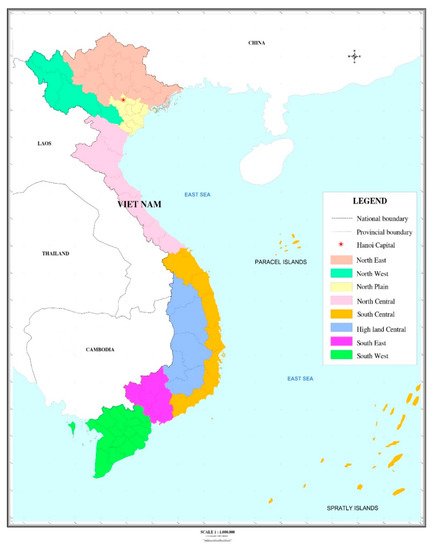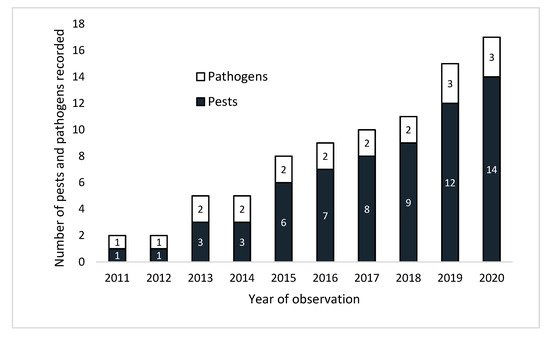
| Version | Summary | Created by | Modification | Content Size | Created at | Operation |
|---|---|---|---|---|---|---|
| 1 | Pham Quang Thu | + 1128 word(s) | 1128 | 2021-09-30 08:01:22 | | | |
| 2 | Rita Xu | + 705 word(s) | 1833 | 2021-11-23 03:51:30 | | |
Video Upload Options
The planted forest area in Vietnam increased from 3.0 to 4.4 million hectares in the period 2010–2020, but the loss of productivity from pests and diseases continues to be a problem. During this period, frequent and systematic plantation forest health surveys were conducted on 12 native and 4 exotic genera of trees as well as bamboo across eight forest geographic regions of Vietnam. Damage caused by insects and pathogens was quantified in the field and laboratory in Hanoi.
1. Introduction
2. Field Surveys—General Procedures

| Host | Area in 2020 (ha) | Planting Region * | Native/Exotic | Commercial Use |
|---|---|---|---|---|
| Acacia spp. and hybrids | 2,000,000 | NE, NW, NP, NC, SC, HC, SE, SW | Exotic | Paper, plywood, timber for construction and furniture |
| Ailanthus triphysa | 500 | NE, NC, SC, SE | Native | Plywood |
| Chukrasia tabularis | 35,000 | NE, NW, NP, NC, SC, HC | Native | Timber for furniture |
| Cinnamomum cassia | 210,000 | NE, NW, NC, SC | Native | Bark for export and seasoning, oil for medicine |
| Dalbergia tonkinensis | 2000 | NE, NW, NP, NC, SC, HC, SE | Native | Timber for furniture and handcrafts |
| Dendrocalamus barbatus | 120,000 | NE, NW, NP, NC | Native | Culm for construction, activated carbon, handcrafts and paper, young shoots for food |
| Dendrocalamus latiflorus | 15,000 | NE, NW, NP, NC, SE | Exotic | Young shoots for food, culm for paper |
| Dipterocarpus alatus | 20,000 | NC, SC, HC, SE | Native | Timber for furniture, construction |
| Eucalyptus spp. and hybrids | 400,000 | NE, NW, NP, NC, SC, HC, SE, SW | Exotic | Paper, plywood, timber for construction |
| Fernandoa brilletii | 6000 | NE, NW, NC | Native | Timber for furniture |
| Hopea odorata | 20,000 | NC, SC, HC, SE | Native | Timber for furniture and boat |
| Illicium verum | 42,000 | NE, NW | Native | Fruit for export and seasoning, oil for medicine |
| Melaleuca cajuputi | 36,000 | NE, NP, NC, SC, SW | Native | Paper, activated carbon, poles for construction |
| Melaleuca leucadendra | 32,000 | SE, SW | Exotic | Paper, activated carbon, poles for construction |
| Nauclea orientalis | 500 | SE, SW | Native | Plywood |
| Neolamarckia cadamba | 1000 | NE, NC, SE, SW | Native | Plywood |
* Forest zones (see Figure 1): NE, North East; NW, North West; NP, North Plain; NC, North Central; SC, South Central; HC, Highland Central; SE, South East; SW, South West.
3. Field Surveys—Insects
4. Change over Time

| Group | Species | Tree Species | Damaged Part |
|---|---|---|---|
| Pests | |||
| Coleoptera | Batocera lineolata | Eucalyptus hybrids | Boles |
| Euwallacea fornicatus | Acacia auriculiformis Acacia mangium Acacia hybrids Cinnamomum cassia |
Boles | |
| Lycaria westermanni | Fernandoa brilletii | Leaves | |
| Tapinolachnus lacordairei | Chukrasia tabularis | Boles | |
| Xyleborus perforans | Acacia hybrids Eucalyptus urophylla |
Boles | |
| Xystrocera festiva | Acacia mangium | Boles | |
| Hemiptera | Aulacaspis tubercularis | Cinnamomum cassia | Leaves |
| Helopeltis theivora | Acacia auriculiformis Acacia mangium Acacia hybrids Cinnamomum cassia Melaleuca cajuputi Melaleuca leucadendra |
Young leaves, shoots | |
| Lepidoptera | Antheraea frithi | Dipterocarpus alatus Hopea odorata |
Leaves |
| Arthroschista hilaralis | Neolamarckia cadamba Nauclea orientalis |
Leaves | |
| Atteva fabriciella | Ailanthus triphysa | Young leaves, shoots | |
| Krananda semihyalina | Cinnamomum cassia | Leaves | |
| Moduza procris | Neolamarckia cadamba Nauclea orientalis |
Leaves | |
| Orthoptera | Hieroglyphus tonkinensis | Dendrocalamus barbatus Dendrocalamus latiflorus |
Young leaves |
| Pathogens | |||
| Fungi | Ceratocystis manginecans | Acacia auriculiformis Acacia mangium Acacia hybrids Chukrasia tabularis Dalbergia tonkinensis Eucalyptus camaldulensis Eucalyptus urophylla |
Boles |
| Fusarium solani | Dendrocalamus latiflorus | Shoots, roots | |
| Oomycete | Phytophthora acaciivora | Acacia mangium Acacia hybrids |
Roots and dieback of seedlings |
| Organism | 2011 | 2012 | 2013 | 2014 | 2015 | 2016 | 2017 | 2018 | 2019 | 2020 |
|---|---|---|---|---|---|---|---|---|---|---|
| Pest | ||||||||||
| Antheraea frithi | SE | SE, SW | SE, SW | SE, SW | ||||||
| Arthroschista hilaralis | SW | SW | SW | SW | SW | SW | ||||
| Atteva fabriciella | NE | NE | NE | NE | NE | |||||
| Aulacaspis tubercularis | SW | SW, SC | SW, SC, NE, NP | SW, SC, NE, NP | SW, SC, NE, NP | SW, SC, NE, NP | ||||
| Batocera lineolata | NW | NE, NW | ||||||||
| Euwallacea fornicatus | NE, SC, HC | NE, SC, HC | NE, SC, HC | NE, NW, NC, SC, SE, HC | NE, NW, NC, SC, SE, HC | NE, NW, NC, SC, SE, HC | NE, NW, NC, SC, SE, SW, HC | NE, NW, NC, SC, SE, SW, HC | ||
| Helopeltis theivora | NC, NW, NE, HC, SE, SW | |||||||||
| Hieroglyphus tonkinensis | NW, NE, NC | NW, NE, NC | NW, NE, NC | NW, NE, NC | NW, NE, NC | NW, NE, NC | NW, NE, NC | NW, NE, NC | NW, NE, NC | NW, NE, NC |
| Krananda semihyalina | NE, NP | |||||||||
| Lycaria westermanni | NC | NC, NE, NW | NC, NE, NW | |||||||
| Moduza procris | SW | SW | SW | SW | SW | SW | ||||
| Tapinolachnus lacordairei | NW | NE, NW, NC | ||||||||
| Xyleborus perforans | NE | NE, SE, SW | ||||||||
| Xystrocera festiva | HC | HC | HC | HC, SC | HC, SC | HC, SC | HC, SC | HC, SC | ||
| Pathogen | ||||||||||
| Ceratocystis manginecans | NE, NW, NC | NE, NW, NC | NE, NW, NC | NE, NW, NC, SE | NE, NW, NP, NC, SE, SW | NE, NW, NP, NC, SC, SE, SW | NE, NW, NP, NC, SC, HC, SE, SW | NE, NW, NP, NC, SC, HC, SE, SW | NE, NW, NP, NC, SC, HC, SE, SW | NE, NW, NP, NC, SC, HC, SE, SW |
| Fusarium solani | NE | NE | ||||||||
| Phytophthora acaciivora | NE | NE | NE | NE | NE | NE | NE | NE | ||
Note: NE. North East; NW. North West; NP. North Plain; NC. North Central; SC. South Central; HC. Highland Central; SE. South East; SW. South West.
References
- Meyfroidt, P.; Lambin, E.F. The causes of the reforestation in Vietnam. Land Use Policy 2008, 25, 182–197.
- Cochard, R.; Nguyen, V.H.T.; Ngo, D.T.; Kull, C.A. Vietnam’s forest cover changes 2005–2016: Veering from transition to (yet more) transaction? World Dev. 2020, 135, 105051.
- MARD. Decision No. 1439/QD-BNN-TCLN Dated 13/4/2021 of the Ministry of Agriculture and Rural Development of Vietnam on Announcing the State of Forests Nationwide in 2020; Ministry of Agriculture and Rural Development: Hanoi, Vietnam, 2021; p. 8.
- Vietnam Report on the Implementation Result of the Five Million Hectares New Afforestation Project and the Forest Protection and Development Program in the 2011–2020 Periods; The Socialist Republic of Vietnam: Hanoi, Vietnam, 2011; p. 34.
- Vietnam Decision No. 523/QD-TTg Dated 1/4/2021 of the Prime Minister of the Socialist Republic of Vietnam on Approving the Vietnam Forestry Development Strategy for the Period of 2021–2030, with a Vision to 2050; The Socialist Republic of Vietnam: Hanoi, Vietnam, 2021; p. 23.
- MARD. Wood Processing Industry, Wood and Forest Product Export in 2018-Successes. Lessons Learned. Breakthrough Solutions in 2019; Ministry of Agriculture and Rural Development: Hanoi, Vietnam, 2019; p. 15.
- Cuong, T.; Chinh, T.T.Q.; Zhang, Y.; Xie, Y. Economic performance of forest plantations in Vietnam: Eucalyptus, Acacia mangium, and Manglietia Conifera. Forests 2020, 11, 284.
- Khuc, Q.V.; Le, T.A.T.; Nguyen, T.H.; Nong, D.; Tran, B.Q.; Meyfroidt, P.; Tran, T.; Duong, P.B.; Nguyen, T.T.; Tran, T.; et al. Forest cover change, households’ livelihoods, trade-offs, and constraints associated with plantation forests in poor upland-rural landscapes: Evidence from North Central Vietnam. Forests 2020, 11, 548.
- Tham, L.T.; Darr, D.; Pretzsch, J. Contribution of small-scale Acacia hybrid timber production and commercialization for livelihood development in Central Vietnam. Forests 2020, 11, 1335.
- MOIT. Vietnam Import and Export Report 2020; Industry and Trade Publisher: Hanoi, Vietnam, 2021; p. 252.
- Iwanaga, S.; Hoang, D.T.; Kuboyama, H.; Duong, D.T.; Tuan, H.H.; Minh, N.V. Changes in the Vietnamese timber processing industry: A case of Quang Tri province, North Central region. Forests 2021, 12, 984.
- Andjic, V.; Dell, B.; Barber, P.; Hardy, G.; Wingfield, M.; Burgess, T. Plants for planting; indirect evidence for the movement of a serious forest pathogen, Teratosphaeria destructans, in Asia. Eur. J. Plant Pathol. 2011, 131, 49–58.
- Burgess, T.I.; Wingfield, M.J. Pathogens on the move: A 100-year global experiment with planted eucalypts. Bioscience 2017, 67, 14–25.
- Crous, P.W.; Wingfield, M.J.; Cheewangkoon, R.; Carnegie, A.J.; Burgess, T.I.; Summerell, B.A.; Edwards, J.; Taylor, P.W.J.; Groenewald, J.Z. Foliar pathogens of eucalypts. Stud. Mycol. 2019, 94, 125–298.
- Wingfield, M.J.; Roux, J.; Wingfield, B.D. Insect pests and pathogens of Australian acacias grown as non-natives—An experiment in biogeography with far-reaching consequences. Divers. Distrib. 2011, 17, 968–977.
- Old, K.M.; Dudzinski, M.J.; Pongpanich, K.; Yuan, Z.Q.; Thu, P.Q.; Nguyen, T.N. Cryptosporiopsis leaf spot and shoot blight of eucalypts. Australas. Plant Pathol. 2002, 31, 337–344.
- Old, K.M.; Wingfield, M.J.; Yuan, Z.Q. A Manual of Diseases of Eucalyptus in South-East Asia; CIFOR: Canberra, Australia, 2003; p. 106.
- Thu, P.Q.; Griffiths, M.W.; Pegg, G.S.; McDonald, J.; Wylie, F.R.; King, J.; Lawson, S.A. Healthy Plantations. A Field Guide to Pests and Pathogens of Acacia, Eucalyptus and Pinus in Vietnam; Department of Employment, Economic Development and Innovation: Queensland, Australia, 2010; p. 124.
- Dell, B.; Xu, D.; Thu, P.Q. Managing threats to the health of tree plantations in Asia. In New Perspectives in Plant Protection; Bandani, A.R., Ed.; InTech: Rijeka, Croatia, 2012; pp. 63–92.
- Thu, P.Q.; Dell, B.; Burgess, T.I. Susceptibility of 18 eucalypt species to the gall wasp Leptocybe invasa in the nursery and young plantations in Vietnam. ScienceAsia 2009, 35, 113–117.
- Thu, P.Q. Results of a survey of insect pests and diseases of the main forest plantation species in Vietnam. Vietnam J. For. Sci. 2016, 1, 4257–4264.
- Thu, P.Q. Status of a Pine wilt nematode in Vietnam. N. Z. J. For. Sci. 2003, 33, 336–342.
- Thu, P.Q. Die-back disease of Eucalyptus urophylla caused by bacteria Ralstonia solanacearum (Yabauchi et al. 1995) Smith. Sci. Tech. J. Agric. Rural Dev. 2006, 5, 90–91.
- Thu, P.Q.; Binh, L.V. Longhorned beetle (Aeolesthes holosericea (Fabricus)) damages stem of Melia azedarach Linnaeus. Sci. Tech. J. Agric. Rural Dev. 2010, 7, 84–88.
- Thu, P.Q.; Binh, L.V.; Sinh, L.V. Longhorn beetle damages Rhizophora apiculata plantation in mangrove forest in Can Gio, Ho Chi Minh city. Sci. Tech. J. Agric. Rural Dev. 2008, 8, 84–87.
- Thu, P.Q.; Quang, D.N.; Dell, B. Threat to cedar, Cedrela odorata, plantations in Vietnam by the weevil, Aclees sp. J. Insect Sci. 2010, 10, 192.
- Nguyen, B.T.; Dao, X.T. Pests and Diseases and Plant Protection Measures; Agricultural Publisher: Hanoi, Vietnam, 2004; p. 168.




